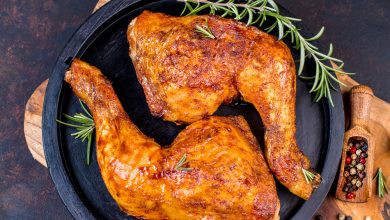Healthy Eating Made Easy: Top Nutritional Facts About Chicken Breast

In today’s fast-paced world, maintaining a healthy diet is more important than ever. Healthy eating not only fuels our bodies but also has a profound impact on our overall well-being, from boosting energy levels to supporting mental health and reducing the risk of chronic diseases. Among the myriad of nutritious food options available, chicken breast stands out as a popular choice due to its versatility, affordability, and impressive nutritional profile.
Chicken breast is widely celebrated for being a lean source of high-quality protein, making it a staple in many diets. Whether you are aiming to build muscle, manage your weight, or simply enjoy a delicious and nutritious meal, chicken breast can be an excellent addition to your culinary repertoire.
The purpose of this blog is to delve into the top nutritional facts about chicken breast, providing you with valuable insights that can enhance your understanding and appreciation of this common dietary staple. We will explore its macronutrient content, essential vitamins and minerals, and the numerous health benefits it offers. Plus, we will share some practical cooking tips and mouthwatering recipes to help you make the most out of this nutritious ingredient. Let’s embark on this journey to make healthy eating easy and enjoyable!
Section 1: Nutritional Breakdown
When it comes to the nutritional composition of chicken breast, it is clear why it is a go-to choice for health-conscious individuals. Chicken breast is predominantly composed of macronutrients that are crucial for bodily functions and overall health. One highlight is its remarkable protein content; with approximately 31 grams of protein per 100 grams, chicken breast provides all the essential amino acids necessary for muscle repair, growth, and maintenance. Additionally, it is low in fat, containing only about 3.6 grams of total fat per 100 grams, with minimal saturated fat. This makes it an ideal protein source for those looking to manage their fat intake. Remarkably, chicken breast is virtually devoid of carbohydrates, making it suitable for low-carb and ketogenic diets.
Beyond macronutrients, chicken breast is rich in essential vitamins and minerals that support various bodily functions. It is an excellent source of Vitamin B6, which plays a pivotal role in brain development and function. The presence of phosphorus aids in the formation of strong bones and teeth, while niacin (Vitamin B3) contributes to the maintenance of healthy skin and nerves. Additionally, chicken breast contains selenium, a powerful antioxidant that helps protect cells from damage and boosts the immune system. These nutritional attributes make chicken breast a nutritional powerhouse that can contribute to a balanced and healthful diet.
Section 2: Health Benefits
Chicken breast’s impressive nutritional profile translates into numerous health benefits that can support overall well-being.
Firstly, its high protein content is a cornerstone for muscle building and repair, making it a favourite among athletes and fitness enthusiasts. Adequate protein intake helps repair muscle fibres that break down during exercise, promoting growth and increased strength.
Furthermore, chicken breast is a valuable ally in weight management. Due to its low-fat content and high protein levels, it helps keep you fuller for longer, reducing overall calorie intake without sacrificing essential nutrients. Additionally, the lean nature of chicken breast supports heart health by contributing to lower cholesterol levels compared to fattier protein sources.
Finally, the presence of phosphorus in chicken breast aids in maintaining strong and healthy bones, working alongside calcium to enhance bone structure and durability. Incorporating chicken breast into your diet can, therefore, provide a robust foundation for maintaining muscle health, managing weight effectively, supporting cardiovascular health, and strengthening bones.
Section 3: Cooking and Preparation Tips
Preparing chicken breast in a healthy and delicious way can be simple and enjoyable, thanks to a variety of cooking methods and recipes available. Grilling, baking, and poaching are all excellent techniques that help retain the nutritional value of chicken breast while minimizing the need for added fats. For a quick and nutritious meal, try grilling chicken breast and pairing it with a side of steamed vegetables like broccoli, carrots, and green beans.
Baking chicken breast with a mix of herbs and a drizzle of olive oil can result in a juicy and flavourful dish that complements a wide range of sides. Another nutritious and easy-to-prepare option is a chicken breast salad, loaded with fresh greens, cherry tomatoes, cucumbers, and avocados, finished with a light vinaigrette.
For a more hearty meal, a chicken and quinoa stir-fry combines the lean protein of chicken with the rich nutrients of quinoa, along with a medley of colourful vegetables for a satisfyingly balanced dish. By embracing these healthy cooking methods and simple recipes, you can enjoy the versatility and benefits of chicken breast in your everyday meals.
Section 4: Frequently Asked Questions (FAQs)
How does chicken breast compare to other protein sources? Chicken breast stands out among protein sources due to its high protein content and low fat levels. Compared to red meat, such as beef or lamb, chicken breast provides a leaner option with significantly less saturated fat, making it heart-healthier. It also offers more protein per calorie than plant-based options like beans and legumes, making it a favoured choice for muscle building and weight management.
Is it better to eat chicken breast with or without skin? For those aiming to reduce their fat intake, eating chicken breast without the skin is the better option. The skin adds additional calories and saturated fat, which can counteract the benefits of the lean meat underneath. However, leaving the skin on during cooking can help retain moisture and flavour, and can be removed before consumption if desired.
Can chicken breast be part of a low-carb diet? Absolutely, chicken breast is an excellent addition to low-carb and ketogenic diets. It is virtually devoid of carbohydrates, allowing you to enjoy a protein-rich meal without affecting your carb limit. Pairing it with low-carb vegetables and healthy fats can help you create balanced, satisfying, and nutritious meals that align with your dietary goals.
Conclusion
In summary, chicken breast is a nutritional powerhouse that can play a pivotal role in a healthy diet. Its high protein content supports muscle repair and growth, making it an ideal choice for fitness enthusiasts, while its low fat levels contribute to heart health and effective weight management.
Additionally, chicken breast is rich in essential vitamins and minerals like Vitamin B6, phosphorus, niacin, and selenium, which support various bodily functions including brain development, bone formation, and immune system health. Whether grilled, baked, or included in a hearty stir-fry, chicken breast stands out as a versatile and delicious option for any meal.
We encourage you to incorporate chicken breast into your balanced diet to reap these impressive health benefits. Experiment with different cooking methods and recipes to keep your meals exciting and nutritious. We would love to hear from you—feel free to share your favorite chicken breast recipes or tips in the comments below. Let’s inspire each other to maintain a healthy and enjoyable eating routine!
We hope you enjoyed reading about “Healthy Eating Made Easy: Top Nutritional Facts About Chicken Breast” and found the information helpful and inspiring for your journey towards a healthier lifestyle. For more insightful articles and tips on healthy eating, subscribe to our blog and stay updated with the latest nutritional advice, recipes, and wellness strategies.



